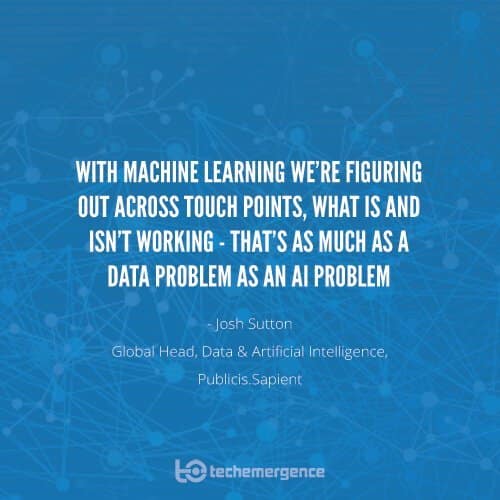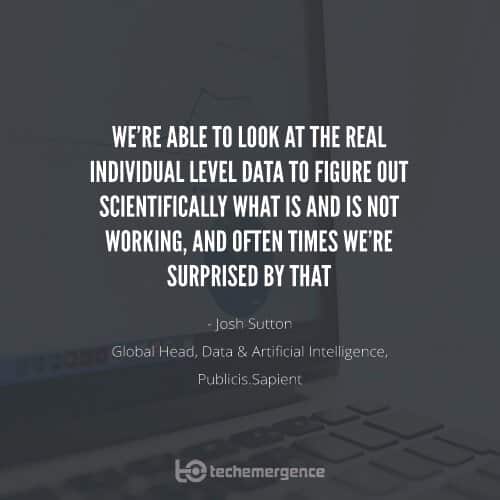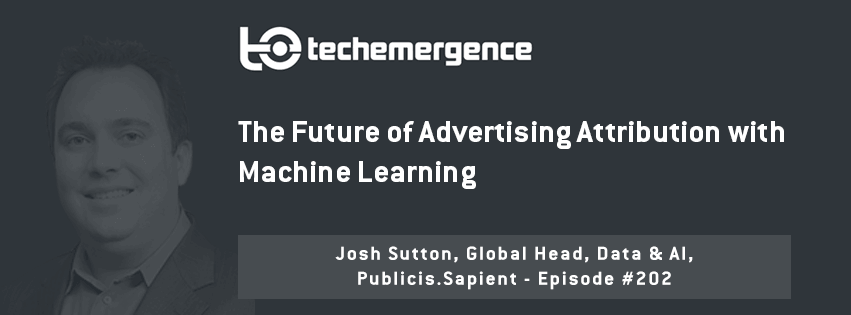Episode Summary: A medium-size business with a $20m marketing budget can run into issues when aiming to track an attribute, what marketing dollars brought in customers, etc. But when you’re managing $90B for customers all over the world and working in every conceivable channel, things get all the more complicated. Josh Sutton, global head of Data and AI at Publicis.Sapient, speaks in this episode about the future of advertising attribution with machine learning. Specifically, Sutton discusses how his team of publicists is working on managing, tracking, and determining cohorts and attribution across more channels and numerous clients, and touches on ways that the company is applying ML to make sense of marketing data and spend marketing dollars more effectively.
Expertise: Capital markets and risk management; artificial intelligence and advanced analytics
Brief Recognition: Josh Sutton leads Publicis.Sapient’s Artificial Intelligence Practice, helping companies leverage established and emerging artificial intelligence platforms to generate business insights, drive customer engagement, and accelerate business processes. Sutton was previously vice president and managing director of Sapient Global Markets, and when he first joined served as vice president of Trading and Risk Management for 15 years. Sutton is a graduate of MIT University.
Current Affiliations: Global Head of Data and AI at Publicis.Sapient; Board Member of NPower

Interview Highlights
The following is a condensed version of the full audio interview, which is available in the above links on Emerj’s SoundCloud and iTunes stations.
(1:38) The basic dynamics of the shift in advertising and marketing…you’re seeing the shift from the big idea and more vague branding to much more targeted marketing, summarize that dynamic for everyone listening.
Josh Sutton: “It’s an industry going through a massive transformation right now, the advertising industry has been relatively consistent for the better part of 50 years…
…As we get more and more data it’s a very dramatic shift from putting out one big campaign to much more directed targeting – the right person, the right platform, the right moment – to drive individual level behaviors within those people…”
(3:14) How does attribution and specificity make its way through some of those broader channels?
JS: “We manage close to $90B worth of spend for our clients…across all channels. What we started to look at is, how do we really understand people at an individual level? We collect data from pretty much any imaginable source that you can think of, and as we become more of an IoT society…we’re capitalizing (on aggregate) on all of that data into effectively a huge data lake the we can look at, and then applying ML to figure out what’s actually driving behavior…
…The next piece of the equation is…what does and doesn’t drive response? So as we look at a billboard, an ad on the computer, on TV – which of those individual things and which of those pieces in combination with each other are actually driving people to make purchase decisions, and how can we adjust that on an ongoing basis in real-time to make sure we’re getting the right mix in front of individual people?”

Emerj interviews Publicis.Sapient’s Josh Sutton
(8:42) You mentioned a particular application (analytics) of this broader notion in the airline space – what does this look like in real life?
JS: “Looking at the intersection of data and with advanced analytics on top of it, and a little bit of machine learning into how people’s behavior shifts…we looked for how to optimize media spend as it related to advertising on billboards…”
(13:26) Do you see smaller players, five years in the future, do you see small businesses to some degree accessing, paying for data pools to enrich their information, or themselves tapping into sources on a consistent basis to paint these more accurate customer pictures?
JS: “I do and I think there will be an ecosystem of providers to help companies leverage that data and make better decisions about how they run their business…there’s an entire another wave of business value to be created, which is helping companies to understand their customers…which goes far beyond advertising and into production design, R&D, and how do you steer the future of your company based on what your customers actually care about.”
(15:32) You talked about attribution, what’s really getting someone to make the purchasing decision…in the next 5 years, what are the technology trends that are going to on the aggregate shift us to be able to dial in to what got them to pull the trigger?
JS: “I think it’s actually not ‘no’ attribution, but attribution of every touch point and understanding that at an individual level…
…There’s some machine learning we’ve built in conjunction with Microsoft around looking at each and every interaction that your brand has with an individual, and based on the results of that interaction…refining what that actually means for your personal belief about that product and refining whether they choose to close a transition with you, choose to educate you more about a product, or say ‘you know what, you’re probably not interested’ – it’s really not a single solution, but an individualized solution that would have never been possible before the age of AI.”

Big Ideas
1 – The value in applying advanced analytics and machine learning to client data (for advertising and marketing purposes) is insight gained into who a company should be targeting for customers and more effective ways to spend marketing money.
2 – Big data and machine learning are turning traditionally static and costly means of advertising into more cost-efficient, targeted forms of marketing that reach people on a more “intimate” level (Nervana Systems’ Naveen Rao has a similar idea about personalization applied to AI at large). Sutton sees the near-future of the advertising industry as correlating with much happier customers, and in turn more profitable companies.



















